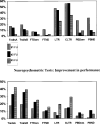Neuropsychometric changes in patients after carotid endarterectomy
- PMID: 9626280
- PMCID: PMC2435204
- DOI: 10.1161/01.str.29.6.1110
Neuropsychometric changes in patients after carotid endarterectomy
Abstract
Background and purpose: One hundred twelve patients undergoing elective carotid endarterectomy for symptomatic and asymptomatic carotid artery stenosis were enrolled in a prospective study to evaluate the incidence of change in postoperative cerebral function.
Methods: Patients were evaluated preoperatively and postoperatively before hospital discharge and at follow-up 1 and 5 months later with a battery of neuropsychometric tests. The results were analyzed by both event-rate and group-rate analyses. For event-rate analysis, change was defined as either a decline or improvement in postoperative neuropsychometric performance by 25% or more compared with a preoperative baseline.
Results: Approximately 80% of patients showed decline in one or more test scores, and 60% had one or more improved test scores at the first follow-up examination. The percentage of declined test scores decreased and the percentage of improved test scores increased with subsequent follow-up examinations. Group-rate analysis was similar for group performance on individual tests. However, a decline in performance was seen most commonly on verbal memory tests, and improved performance was seen most commonly on executive and motor tests.
Conclusions: Neuropsychometric evaluation of patients undergoing carotid endarterectomy for significant carotid artery stenosis demonstrates both declines and improvements in neuropsychometric performance. The test changes that showed decreased performance may be associated with ischemia from global hypoperfusion or embolic phenomena, and the improvement seen may be related to increased cerebral blood flow from removal of stenosis.
Figures

References
-
- NASCET Collaborators Beneficial effect of carotid endarterectomy in symptomatic patients with high-grade carotid stenosis. N Engl J Med. 1991;325:445–453. - PubMed
-
- ECSTC Group MRC European Carotid Surgery Trial: interim results for symptomatic patients with severe (70−99%) or with mild (0−29%) carotid stenosis. Lancet. 1991;337:221–227. - PubMed
-
- ACA Study Endarterectomy for asymptomatic carotid artery stenosis. JAMA. 1995;273:1421–1428. - PubMed
-
- Hobson RW, II, Weiss DG, Fields WS, Goldstone J, Moore WS, Towne JB, Wright CB, the TVACS Group Efficacy of carotid endarterectomy for asymptomatic carotid stenosis. N Engl J Med. 1993;328:221–227. - PubMed
-
- Shaw PJ, Bates D, Cartlidge NEF, French JM, David H, Julian DG, Shaw DA. Neurologic and neuropsychological morbidity following major surgery: comparison of coronary artery bypass and peripheral vascular surgery. Stroke. 1987;18:700–707. - PubMed
Publication types
MeSH terms
Grants and funding
LinkOut - more resources
Full Text Sources
Medical

